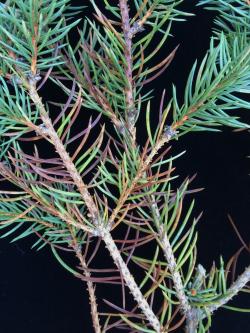Rhizosphaera needle cast has become a major disease of Colorado blue spruce (Picea pungens), white spruce (P. glauca) and Oriental spruce (P. orientalis) in landscape settings. The genus Rhizosphaera contains many species that are capable of attacking most landscape conifers in the region, including: true fir (Abies), hemlock (Tsuga), pine (Pinus), spruce (Picea), Douglas-fir (Pseudotsuga) and true cedar (Cedrus). While trees are rarely, if ever, killed by the disease alone, Rhizospharea is an important contributor to decline when other stresses are present, especially drought.
Mild temperatures and prolonged needle wetness favor disease development. The pathogen invades susceptible needles through the stomata (pores used for gas exchange) and overwinters in diseased needles that have fallen to the ground or those that remain in the canopy. Beginning in the spring and lasting through the autumn, spores are dispersed from infected needles by wind and splashing rainwater. Younger needles on interior portions of lower canopy branches are most commonly infected. In these locations air flow is limited, shade is more abundant and free moisture lingers on needles longer.
 Once needles are infected, symptoms may take 12 months or longer to become visible. When trees are stressed, symptoms of infection may develop more rapidly. On blue and white spruce, diseased needles often first appear purple, becoming brown to straw-colored. When the disease becomes well established in the lower canopy of a tree, Rhizosphaera then spreads upward in successive years, gradually leading to increased rates of premature needle shedding. In certain settings, mature trees can be severely defoliated, leaving only a small tuft of live foliage in the upper canopy. Pycnidia (small, black-colored fruiting bodies of the fungus through which spores are discharged) develop on the surface of infected needles and can be observed with the naked eye or a 10X hand lens during almost any season. They appear as fuzzy black, sooty dust. On spruce, the pycnidia are present on all sides of the needle, whereas on fir, they occur only on the underside of the needle.
Once needles are infected, symptoms may take 12 months or longer to become visible. When trees are stressed, symptoms of infection may develop more rapidly. On blue and white spruce, diseased needles often first appear purple, becoming brown to straw-colored. When the disease becomes well established in the lower canopy of a tree, Rhizosphaera then spreads upward in successive years, gradually leading to increased rates of premature needle shedding. In certain settings, mature trees can be severely defoliated, leaving only a small tuft of live foliage in the upper canopy. Pycnidia (small, black-colored fruiting bodies of the fungus through which spores are discharged) develop on the surface of infected needles and can be observed with the naked eye or a 10X hand lens during almost any season. They appear as fuzzy black, sooty dust. On spruce, the pycnidia are present on all sides of the needle, whereas on fir, they occur only on the underside of the needle.
Conifers vary in their susceptibility to the disease, so if disease pressure in the landscape is high, choose resistant trees such as Norway spruce for new plantings. The disease is more destructive on spruce planted in shaded settings or in tight hedgerows. Most spruces are shade intolerant and prefer full sun with no surrounding plants to thrive. Environmental stresses such as drought, deep planting and mechanical root injury contribute to disease severity. Additionally, opportunistic stem cankering fungi and insect pests also contribute to disease severity by reducing host vigor. Fungicides can be effective in certain cases but will likely have little impact once the fungus is well established in the canopy.
For additional information see our Rhizosphaera Needle Cast fact sheet.
